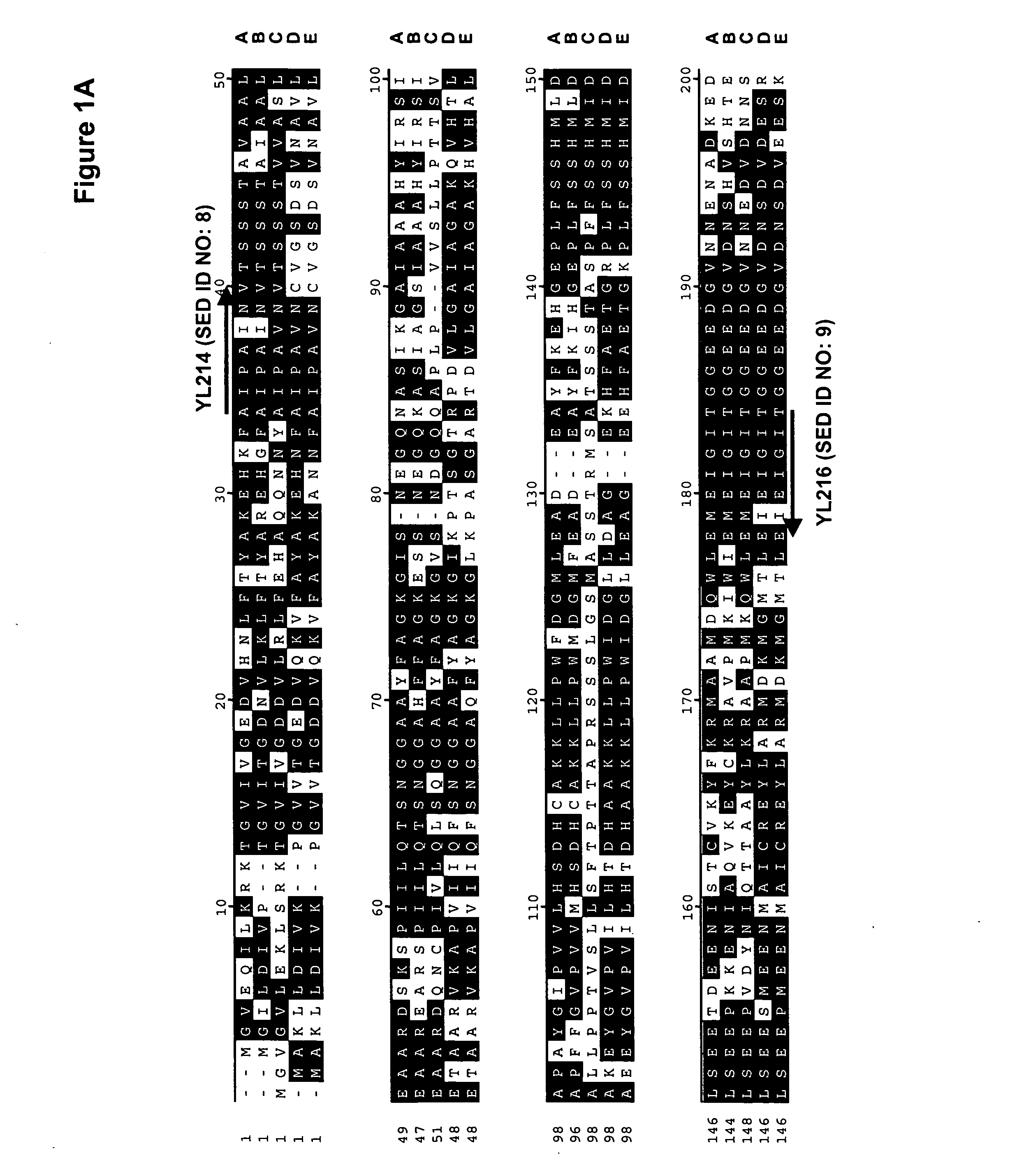Fructose-bisphosphate aldolase regulatory sequences for gene expression in oleaginous yeast
- Summary
- Abstract
- Description
- Claims
- Application Information
AI Technical Summary
Problems solved by technology
Method used
Image
Examples
example 1
Isolation of a Portion of the Coding Region of the Yarrowia lipolytica fba1 Gene
[0194] The present Example describes the identification of a portion of the Yarrowia lipolytica gene encoding FBA1 (SEQ ID NOs:10 and 11), by use of primers derived from conserved regions of other fba1 sequences.
[0195] A comparison of the various protein sequences encoding fba1 genes from Saccharomyces cerevisiae (GenBank Accession No. NP—012863; SEQ ID NO:1), Schizosaccharomyces pombe (GenBank Accession No. NP—595692; SEQ ID NO:2), Aspergillus oryzae (GenBank Accession No. BAB12232; SEQ ID NO:3), Haemophilus influenzae (GenBank Accession No. NP—438682; SEQ ID NO:4) and Pasteurella multocida (GenBank Accession No. NP—246800; SEQ ID NO:5) showed that there were several stretches of conserved amino acid sequence between the 5 different organisms (FIGS. 1A and 1B). Thus, two degenerate oligonucleotides (shown below), corresponding to the conserved ‘AIPAINV’ (SEQ ID NO:6) and ‘EMEIGIT’ (SEQ ID NO:7) amino ...
example 2
Isolation of the 5′ Upstream Regions of the fba1 Gene from Yarrowia lipolytica
[0205] To isolate the promoter for the fba1 gene identified in Example 1, a genome-walking technique (TOPO® Walker Kit, Invitrogen, Carlsbad, Calif.) was utilized.
[0206] Briefly, genomic DNA of Y. lipolytica was digested with KpnI, SacI, SphI or PacI; each digest was then dephosphorylated with Calf Intestinal Alkaline Phosphatase (CIP). Primer extension reactions were then carried out individually using the dephosphorylated DNA as the template and oligonucleotide YL217 (SEQ ID NO:14) as the primer. The primer extended products were linked with TOPO® linker and used as templates for first PCR reactions using primers of LinkAmp Primer1 and YL218 (SEQ ID NO:15). The PCR amplifications were carried out in a 50 μl total volume, comprising: PCR buffer (containing 10 mM KCl, 10 mM (NH4)2SO4, 20 mM Tris-HCl (pH 8.75), 2 mM MgSO4, 0.1% Triton X-100), 100 μg / mL BSA (final concentration), 200 μM each deoxyribonucle...
example 3
Synthesis of pY5-30
[0211] The present Example describes the synthesis of pY5-30 (SEQ ID NO:62), comprising a chimeric TEF::GUS::XPR gene. This was required for comparative studies investigating the promoter activities of the GPD, GPM, TEF, FBA and FBAIN promoters, wherein constructs comprising each promoter and the E. coli gene encoding β-glucuronidase (GUS) as a reporter gene (Jefferson, R. A. Nature. 14(342):837-838 (1989)) were prepared and analyzed (Examples 4-6, infra).
Amplification of the GUS Coding Region
[0212] The GUS coding region was amplified using pBI01 (Jefferson, R. A. et al., EMBO J. 6:3901-3907 (1987)) as template and oligonucleotides YL33 (SEQ ID NO:28) and YL34 (SEQ ID NO:29) as primers. The PCR amplification was carried out in a 50 μl total volume comprising: PCR buffer (containing 10 mM KCl, 10 mM (NH4)2SO4, 20 mM Tris-HCl (pH 8.75), 2 mM MgSO4, 0.1% Triton X-100), 100 μg / mL BSA (final concentration), 200 μM each deoxyribonucleotide triphosphate, 10 pmole of ...
PUM
| Property | Measurement | Unit |
|---|---|---|
| Fraction | aaaaa | aaaaa |
| Fraction | aaaaa | aaaaa |
Abstract
Description
Claims
Application Information
 Login to View More
Login to View More - R&D
- Intellectual Property
- Life Sciences
- Materials
- Tech Scout
- Unparalleled Data Quality
- Higher Quality Content
- 60% Fewer Hallucinations
Browse by: Latest US Patents, China's latest patents, Technical Efficacy Thesaurus, Application Domain, Technology Topic, Popular Technical Reports.
© 2025 PatSnap. All rights reserved.Legal|Privacy policy|Modern Slavery Act Transparency Statement|Sitemap|About US| Contact US: help@patsnap.com



